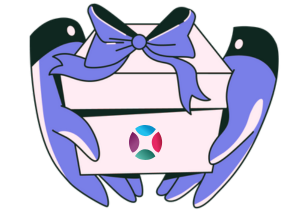Hiring the right people is the backbone of any successful company. Without skilled and motivated employees, even the best business ideas can struggle to take off. But finding top talent isn’t just about posting job openings and hoping for the best, it requires a strategic approach called Talent Acquisition. Unlike traditional recruiting, Talent Acquisition is a long-term, proactive strategy focused on attracting, assessing, and retaining the best candidates. It goes beyond just filling roles—it ensures your company has the right people to drive growth and innovation. Using AI-driven hiring platforms can make this process more efficient, helping businesses identify top candidates with data-backed insights.
Table of Contents
If you’re a recruiter looking to streamline your hiring process and build a strong workforce, this blog is for you. We’ll cover what Talent Acquisition is, how it differs from recruitment and HR, why it’s important, and the best strategies to attract top talent.
What is Talent Acquisition?
Recruiters fill vacancies. They play a critical role in talent acquisition. Recruiters work closely with HR professionals and hiring managers. Their goal is to ensure the organization meets its staffing needs. To summarize, they are responsible for identifying, sourcing, as well as attracting candidates.
It involves:
- Workforce planning – Understanding future hiring needs
- Employer branding – Making your company attractive to top candidates
- Sourcing candidates – Using various channels to find skilled professionals
- Screening and assessments – Evaluating potential hires through tests and interviews
- Onboarding and retention – Ensuring new hires integrate well and stay long-term
Take Google, for instance, a company known for its innovative hiring practices. Google has invested heavily in its Talent Acquisition strategy, and it pays off. In fact, Google receives more than 2 million job applications every year and is known for its rigorous selection process. With a robust Talent Acquisition strategy, Google has consistently managed to hire the world’s brightest minds, contributing to their status as one of the top companies globally. In short, Talent Acquisition is a proactive, strategic approach that helps businesses secure top talent and maintain a competitive edge.
Talent Acquisition Vs Recruiting Vs HR – What’s the Difference?
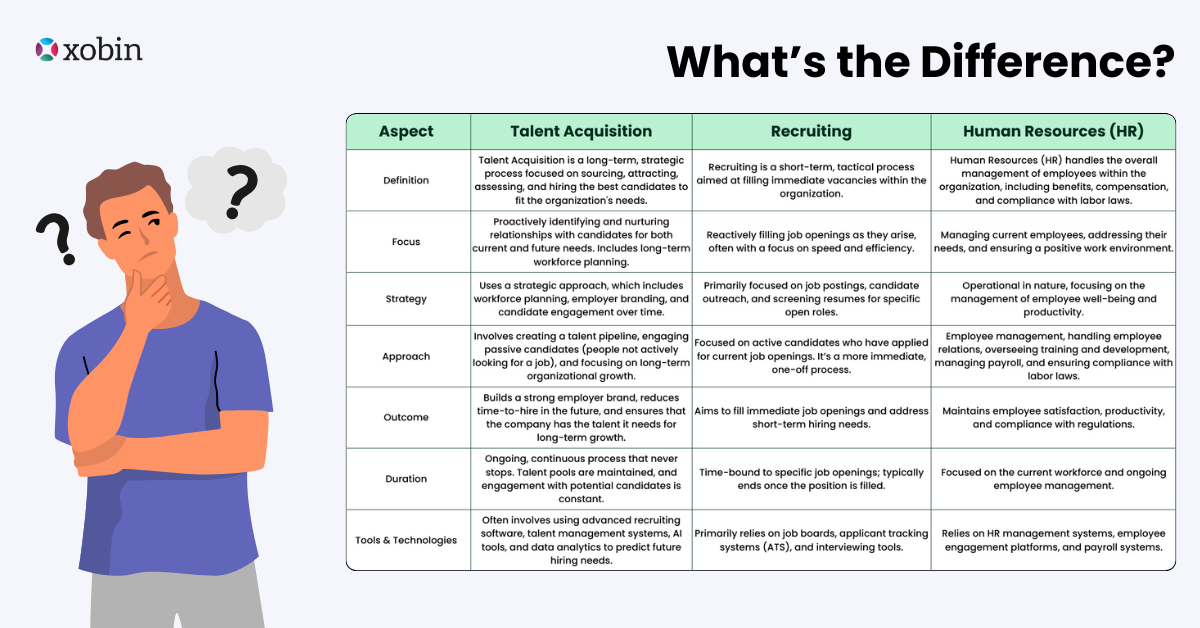
In the world of hiring, the terms Talent Acquisition, Recruiting, and Human Resources (HR) are often used interchangeably, but they each have distinct roles and functions within an organization. Understanding these differences can help recruiters develop a more effective hiring strategy.
Talent Acquisition Vs Recruiting Vs HR
| Aspect | Talent Acquisition | Recruiting | Human Resources (HR) |
| Definition | Talent Acquisition is a long-term, strategic process focused on sourcing, attracting, assessing, and hiring the best candidates to fit the organization’s needs. | Recruiting is a short-term, tactical process aimed at filling immediate vacancies within the organization. | Human Resources (HR) handles the overall management of employees within the organization, including benefits, compensation, and compliance with labor laws. |
| Focus | Proactively identifying and nurturing relationships with candidates for both current and future needs. Includes long-term workforce planning. | Reactively filling job openings as they arise, often with a focus on speed and efficiency. | Managing current employees, addressing their needs, and ensuring a positive work environment. |
| Strategy | Uses a strategic approach, which includes workforce planning, employer branding, and candidate engagement over time. | Primarily focused on job postings, candidate outreach, and screening resumes for specific open roles. | Operational in nature, focusing on the management of employee well-being and productivity. |
| Approach | Involves creating a talent pipeline, engaging passive candidates (people not actively looking for a job), and focusing on long-term organizational growth. | Focused on active candidates who have applied for current job openings. It’s a more immediate, one-off process. | Employee management, handling employee relations, overseeing training and development, managing payroll, and ensuring compliance with labor laws. |
| Outcome | Builds a strong employer brand, reduces time-to-hire in the future, and ensures that the company has the talent it needs for long-term growth. | Aims to fill immediate job openings and address short-term hiring needs. | Maintains employee satisfaction, productivity, and compliance with regulations. |
| Tools & Technologies | Often involves using advanced recruiting software, talent management systems, AI tools, and data analytics to predict future hiring needs. | Primarily relies on job boards, applicant tracking systems (ATS), and interviewing tools. | Relies on HR management systems, employee engagement platforms, and payroll systems. |
Key Takeaway
- Recruiting is about filling roles quickly.
- Talent Acquisition is a long-term hiring strategy.
- HR focuses on employee management after hiring
Why is Talent Acquisition Important?
1. It Helps You Attract Top Talent
One of the primary goals of Talent Acquisition is to attract the best candidates available in the market. Through strategic planning, employer branding, and leveraging various channels like job boards, social media, and employee referrals, a well-executed Talent Acquisition strategy ensures that you’re not just filling positions but you’re building a strong, highly skilled workforce.
Top talent doesn’t just apply to job openings, they are actively looking for companies that align with their values, goals, and career aspirations. By focusing on Talent Acquisition, you create a strong employer brand and increase your chances of attracting high-quality candidates who will add value to your organization.
2. It Reduces Turnover Rates
Hiring the right talent is a significant step in reducing turnover rates. When companies rush to fill positions without considering the long-term fit between the candidate and the organization, it often results in mismatches. This can lead to employees feeling disengaged, resulting in them leaving sooner than expected.
With Talent Acquisition, you’re able to thoroughly assess not just the skills of candidates but also their cultural fit. By focusing on hiring individuals who align with your organization’s values and goals, the likelihood of long-term success increases. This means your new hires are more likely to stay, which leads to lower turnover and reduced costs associated with re-hiring and training.
3. It Improves Business Performance
A company’s business performance is directly impacted by the quality of its workforce. When you hire top-tier candidates through a Talent Acquisition strategy, you ensure that your team has the skills, knowledge, and expertise to drive growth. Whether you’re looking for individuals who excel in innovation, problem-solving, leadership, or collaboration, Talent Acquisition focuses on hiring candidates who can contribute to the company’s objectives.
Furthermore, an efficient Talent Acquisition process helps you find candidates with the right blend of technical skills and soft skills, ensuring they can succeed in their roles and contribute positively to team dynamics and company culture. The outcome? Increased productivity, better problem-solving capabilities, and a more competitive edge in the market.
4. It Saves Time and Costs
Traditional recruitment methods often involve reactive hiring, where companies scramble to fill positions at the last minute. This often leads to rushed decisions and poor hires. The Talent Acquisition approach, on the other hand, is proactive. By planning ahead and continuously building a talent pipeline, you ensure that when a vacancy arises, you already have a pool of qualified candidates to choose from. This reduces the time-to-hire and helps avoid the costs of a prolonged search.
Additionally, Talent Acquisition strategies focus on reducing hiring mistakes by conducting thorough pre- employment screenings, assessments, and background checks. This ensures that you’re making the best choice for the company, saving costs related to turnover, re-hiring, and training new employees.
5. It Strengthens Your Employer Brand
Your employer brand plays a major role in attracting top talent. A company with a strong reputation for treating employees well, offering career growth, and providing a positive work environment will naturally attract better candidates.
Effective Talent Acquisition focuses on promoting your organization’s culture, values, and commitment to employee well-being. This can be done through employer branding initiatives such as sharing success stories, showcasing employee testimonials, and using social media to highlight company values. A strong employer brand makes your company stand out in the competitive job market and increases your chances of attracting candidates who are a perfect fit for your organization.
6. It Provides a Competitive Advantage
In today’s competitive market, companies that invest in Talent Acquisition have a significant edge over competitors. Businesses that prioritize hiring and retaining top talent often perform better than those who only focus on filling positions quickly. Candidates with in-demand skills have multiple opportunities to choose from, and they will often opt for organizations that offer more than just a paycheck. They want companies that invest in their professional development, offer growth opportunities, and align with their personal values.
With Talent Acquisition, you’re able to proactively attract, engage, and secure top talent before your competitors do. This gives you a competitive advantage in the market by building a high-performing team that can innovate, solve problems, and execute the company’s vision effectively.
7. It Aligns with Long-Term Business Goals
A strong Talent Acquisition strategy isn’t just about hiring for immediate needs, it’s about aligning hiring efforts with the long-term goals of the business. As companies grow and evolve, so do their talent needs. By developing a talent acquisition strategy that aligns with business objectives, you ensure that you’re hiring people who will not only fill current gaps but also help drive the organization toward future growth.
For instance, if your business plans to expand into new markets or launch a new product line, you’ll need specific skill sets. By proactively sourcing talent in advance and planning your hiring strategy around these goals, you can ensure that you have the right people in place to support the company’s growth.
8. It Supports Diversity and Inclusion
Talent Acquisition plays a pivotal role in supporting diversity and inclusion (D&I) initiatives within organizations. By using diverse hiring channels, focusing on eliminating biases in the hiring process, and promoting a culture of inclusivity, you create a more balanced and equitable workplace.
Hiring for diversity not only helps create a positive work culture but also improves creativity and innovation. Diverse teams bring different perspectives to problem-solving, leading to better decision-making and a more dynamic work environment. With Talent Acquisition, recruiters can ensure that the hiring process is fair, inclusive, and focused on finding the best candidates regardless of their background.
Effective Talent Acquisition Process
An effective Talent Acquisition process is essential for finding and hiring the right people for your business. It involves several key steps that ensure you not only attract the best candidates but also assess them thoroughly and onboard them successfully. Here’s a breakdown of the Talent Acquisition process designed for recruiters:
1. Workforce Planning
The first step in any successful Talent Acquisition strategy is understanding your business goals and future hiring needs. Workforce planning helps you forecast what positions need to be filled, what skills are required, and when you’ll need to hire. This ensures you’re always ahead of the curve and prepared for upcoming talent needs.
- Identify the skills gaps in your current workforce
- Align hiring plans with your company’s growth objectives
- Regularly review and adjust hiring plans based on business changes
2. Employer Branding
Candidates want to work for companies that align with their values and offer a great workplace culture. A strong employer brand helps you stand out in a competitive job market. It’s about showcasing what makes your company a great place to work and why candidates should choose you over your competitors.
- Share employee testimonials and success stories
- Highlight your company’s culture and values on social media and career pages
- Participate in industry events and career fairs to increase your visibility
3. Sourcing and Recruitment
Once you know what positions you need to fill and have an attractive employer brand, it’s time to source candidates. This step involves using various channels to find potential candidates. Traditional job boards, social media platforms like LinkedIn, and employee referrals are just some of the ways to reach top talent.
- Post job openings on relevant job boards and social media platforms
- Build relationships with recruitment agencies for specialized roles
- Encourage employees to refer qualified candidates through a referral program
4. Screening and Selection
After sourcing candidates, you need to screen and assess them to find the best fit for your company. Screening involves reviewing resumes and applications, while selection includes conducting interviews and skills assessments to evaluate candidates more deeply.
- Use Applicant Tracking Systems (ATS) to streamline resume reviews
- Conduct structured interviews to ensure consistency and fairness
- Implement pre-employment assessments to test technical and soft skills
5. Onboarding and Retention
The final step is ensuring a smooth transition for new hires. Onboarding is critical to making new employees feel welcomed and supported. A strong onboarding process increases employee engagement and helps new hires integrate quickly into their roles.
- Provide clear job expectations and training materials
- Assign mentors or buddies to help new hires settle in
- Regularly check in with new employees to ensure they feel supported and valued
Building a Talent Acquisition Strategy for Your Business
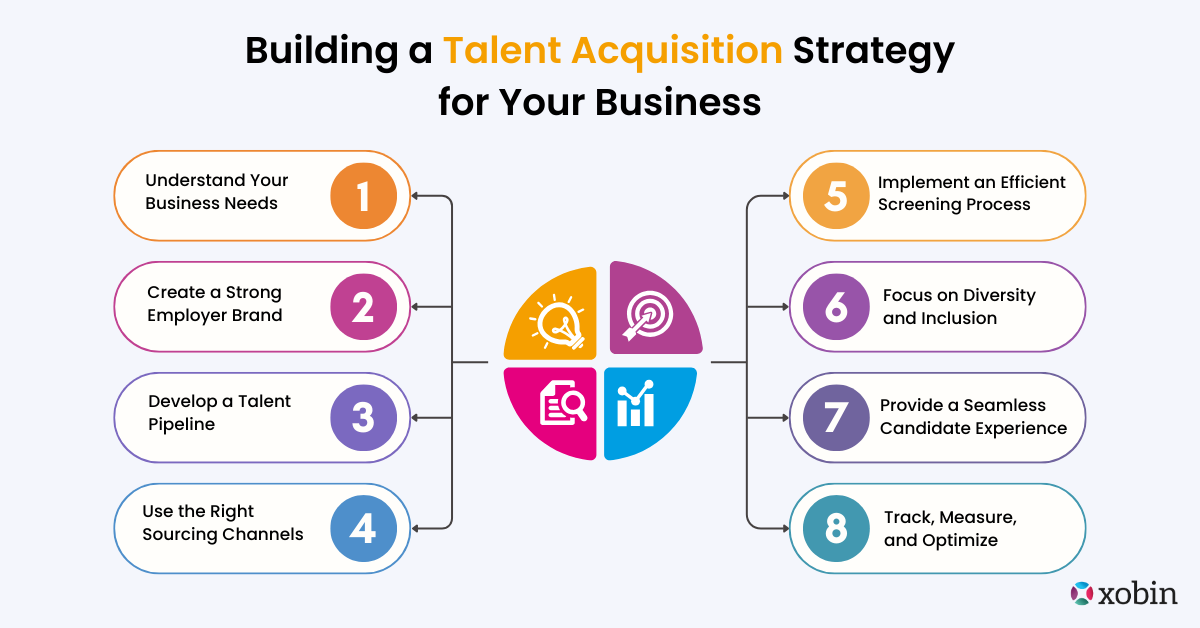
Creating a solid Talent Acquisition strategy is crucial for any recruiter looking to bring the best talent into their organization. It’s about more than just filling positions; it’s about developing a long-term approach that ensures your business attracts the right people at the right time. Here’s how to build a strategy that works:
1. Understand Your Business Needs
The first step in building a Talent Acquisition strategy is understanding your business’s goals and future needs. Start by collaborating with key stakeholders such as department heads and senior leaders to identify areas that need growth. This will help you forecast the skills, experience, and number of hires you’ll need to support these goals.
2. Create a Strong Employer Brand
A compelling employer brand is key to attracting top talent. Talented candidates want to work for organizations that align with their values and offer a positive working environment. Showcase your company’s culture, mission, and benefits on platforms like your website, LinkedIn, and job boards. Happy employee testimonials and stories about work-life balance can also boost your employer brand. Remember, a strong employer brand makes your company stand out to candidates.
3. Develop a Talent Pipeline
Building a talent pipeline is a proactive way to ensure you always have access to qualified candidates. Rather than waiting until a position opens up, build relationships with potential candidates ahead of time. Use social media, professional networks, and industry events to connect with professionals who may not be actively job hunting but are a great fit for your company. Having a talent pool ready to tap into reduces the time it takes to fill positions.
4. Use the Right Sourcing Channels
To build a strong candidate pool, you need to source candidates from multiple channels. Posting job openings on job boards like LinkedIn and Indeed is essential, but don’t stop there. Engage in passive recruitment by reaching out to potential candidates through social media, professional groups, and industry events. Leveraging employee referrals is also highly effective because employees often recommend highly qualified candidates who fit the company culture.
5. Implement an Efficient Screening Process
An effective screening process helps you quickly identify the most qualified candidates. Use structured interviews to ensure consistency across all candidates, and incorporate pre-employment tests to evaluate both technical and soft skills. Consider integrating an ATS that automates resume screening, making it easier to manage a large pool of candidates efficiently.
6. Focus on Diversity and Inclusion
A diverse team brings different perspectives, leading to more innovative ideas and solutions. When building your Talent Acquisition strategy, make diversity and inclusion a priority. Focus on recruiting candidates from a variety of backgrounds and ensure your hiring process is free from biases. This will not only improve your team’s dynamic but also make your company more attractive to diverse candidates.
7. Provide a Seamless Candidate Experience
The candidate experience is a crucial part of your Talent Acquisition strategy. A smooth, positive process ensures that candidates feel respected and valued throughout their journey. This means clear communication, transparency regarding expectations, and timely feedback after interviews. Candidates who have a great experience, even if they’re not hired, are more likely to refer others or even apply for future openings.
8. Track, Measure, and Optimize
Building a Talent Acquisition strategy isn’t a one-and-done process—it requires continuous evaluation and optimization. Track recruitment metrics or KPIs such as time-to-hire, cost-per-hire, and candidate quality. Use this data to identify areas for improvement, adjust sourcing strategies, and refine the screening process. Analyzing results regularly ensures that your strategy evolves with market trends and business needs.
Talent Acquisition Best Practices
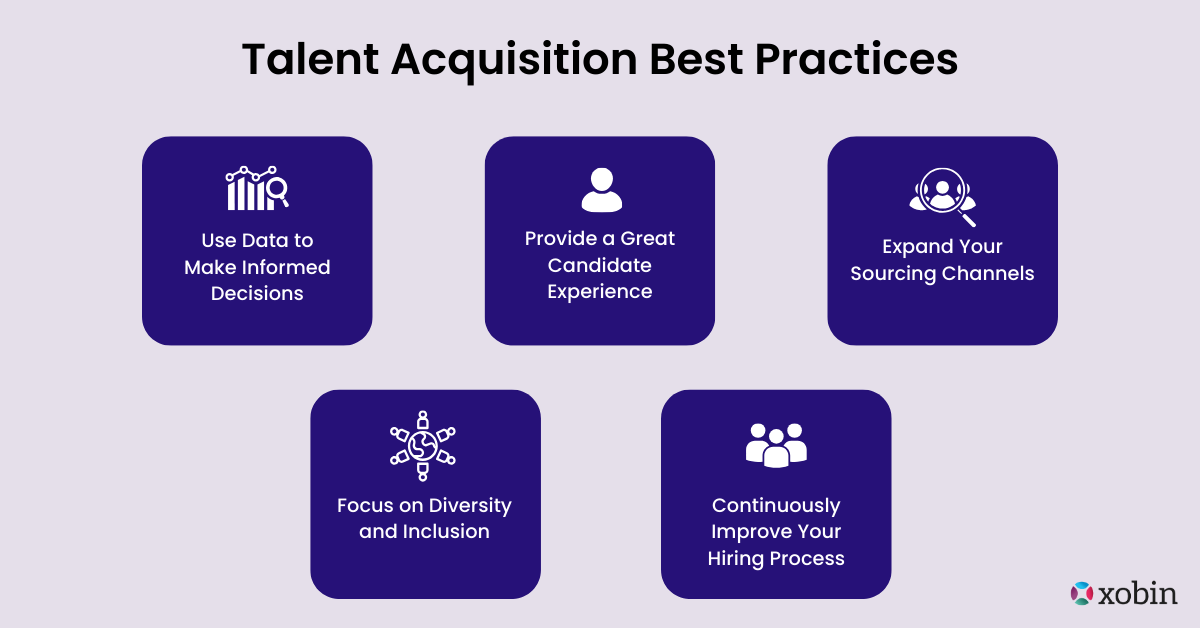
To attract the best candidates and streamline your hiring process, it’s important to follow some key Talent Acquisition best practices. Here are the most effective strategies to help you succeed:
1. Use Data to Make Informed Decisions
With the global marketplace becoming increasingly competitive, attracting and retaining top talent is becoming more challenging. Applicants skip interviews. Candidates turn down job offers. Or worse, some don’t turn up at the last minute. Companies compete to hire skilled workers with the right skills and experience. This has led to a shortage of qualified candidates and huge competition.
2. Provide a Great Candidate Experience
From the first touchpoint to the job offer, the experience candidates have with your company can make a huge difference. A smooth, transparent, and engaging process keeps candidates excited and reflects well on your company. Be clear about timelines, offer feedback, and treat each candidate respectfully. This not only increases the chances of hiring a candidate but also improves your employer brand, making it easier to attract talent in the future.
3. Expand Your Sourcing Channels
Relying on just one or two sources to find candidates limits your options. Instead, use a variety of channels to cast a wider net. Post jobs on multiple job boards, use social media like LinkedIn, attend networking events, and encourage employee referrals. These methods help you reach different types of candidates and increase your chances of finding top talent.
4. Focus on Diversity and Inclusion
A diverse team brings fresh perspectives and innovative ideas. To ensure diversity in your hiring, implement strategies like blind resume screening to reduce bias. Create inclusive job descriptions and promote equal opportunities for everyone, regardless of background, gender, or ethnicity. This will help you attract a broader range of candidates and foster a more inclusive workplace.
5. Continuously Improve Your Hiring Process
Talent Acquisition is an evolving process. Continuously measure the effectiveness of your efforts by tracking key metrics like time-to-hire, quality of hire, and candidate satisfaction. Regularly review and adjust your strategies to align with the needs of your business. If something isn’t working, don’t be afraid to try new tools or methods to improve your process.
Tips for Effective Talent Acquisition
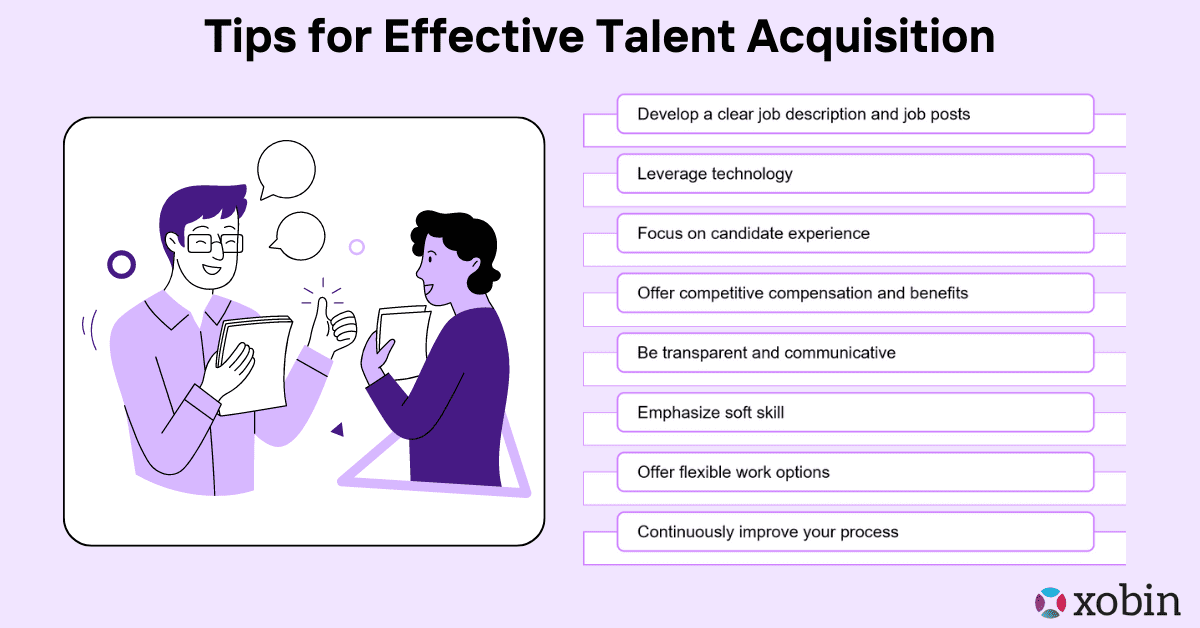
1. Develop a clear job description and job posts
Hiring great talent begins with attracting great talent. Getting there requires you to create an effective job description . One that documents the role’s soft skills, hard skills, and qualifications. The job post, on the other hand, must be creative and engaging. Avoid jargon and over-the-top language. Ensure that the job titles are accurate. It’s a no-brainer that applicants are more likely to apply for a job title that makes sense than an esoteric one.
2. Leverage technology
Building an HR Tech Stack is vital to scaling talent acquisition. Technology can help save time, improve the quality of decisions, and reduce costs. It can help you streamline your recruitment process. Secondly, it helps you keep a track of your key recruitment metrics. Consider using recruitment management software that powers CV screening, job posting, assessments, video interviews and applicant tracking. When considering the implementation of such software, it’s crucial to factor in the associated software development costs. By carefully assessing your budget and exploring cost-effective development options, you can ensure that your investment aligns with your organization’s needs and delivers a high-quality HR tech solution.
3. Focus on candidate experience
The candidate experience is the sum of all candidate interactions with an organization. A poor experience can lead to a rant or a poor review on social media. That would be a PR mess! Creating a positive candidate experience reflects well on your HR team. After all, it makes candidates feel valued and respected.
4. Offer competitive compensation and benefits
Who doesn’t like a good salary? Compensation is one of job seekers’ biggest factors when evaluating job opportunities. It’s vital to offer competitive salary and benefits packages that reflect the value that your organization places on its employees. ESOPS, Insurance benefits, child support benefits, and flexible holiday policy are perks that attract applicants.
5. Be transparent and communicative
Communication is key to creating a positive candidate experience. No candidate likes to be ghosted. Be transparent about the recruitment process. Provide regular updates to candidates to keep them informed and engaged. That’s the only way to earn their trust.
6. Emphasize soft skill
Technical skills and tools are continuously changing. But organizations need problem-solvers and collaborators. Assessing soft skills using psychometric tests and behavioral interviews should be an essential part of your hiring process. Teams with agility and empathy are better equipped to adapt quickly as the future of work continues to evolve.
7. Offer flexible work options
More and more workers are seeking flexible work options to improve their work-life balance. Naturally, organizations and HR teams must embrace this demand for remote work and flexible schedules. Consider offering these options to attract and retain top talent.
8. Continuously improve your process
Talent acquisition is an ongoing process. Organizations of all sizes require continuous improvement on this front. You can identify improvement areas by regularly monitoring metrics such as time-to-fill, and cost-per-hire. HR teams must be open to feedback from candidates, hiring managers, and other stakeholders. They must create that feedback look to optimize the recruitment process.
Hire Top Talent with Xobin!
If you’re ready to optimize your hiring process and attract top candidates, Xobin can help. Xobin is an all-in-one Talent Assessment Software designed to help you find and hire the best candidates efficiently.
With Xobin, you can:
- Streamline hiring with an AI-powered Applicant Tracking System (ATS)
- Assess candidate skills using customizable pre-employment tests
- Ensure fair evaluations with anti-cheating web proctoring
- Enhance candidate experience through a seamless, transparent process
Book a personalized demo today and take your recruitment process to the next level with Xobin!



